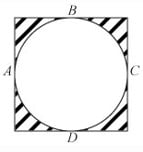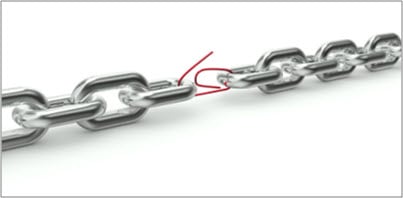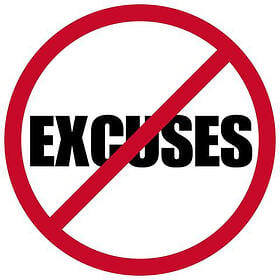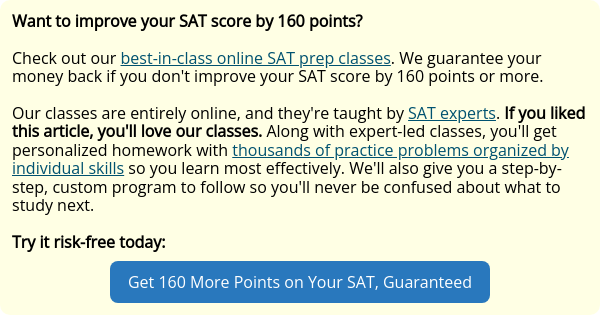
Are you struggling with SAT Math scores between 300-500? You're not alone—hundreds of thousands of students are scoring in this range. But many don't know the best ways to break out of this score range and score a 600 or above.
Here we'll discuss how to improve your SAT math score effectively, and why it's so important to do so. Put these principles to work and I'm confident you'll be able to improve your score.
Brief note: This article is suited for students scoring below a 600 and goes over basic SAT math strategies. If you're already above this range, my perfect SAT Math score article is more appropriate for you.
In this article, I'm going to discuss why scoring high is a good idea, what it takes to score a 600, and then go into test strategies.
(In this guide, I talk mainly about getting to a 600. But if your goal is a 590 or below, these concepts still equally apply).
Understand the Stakes
At this SAT score range, improving your low SAT math score to a 600 range will dramatically boost your chances of getting into better colleges.
Let's take a popular school, University of Alabama, as an example.
Its average SAT score is a 1230. Its 25th percentile score is a 1090, and 75th percentile is a 1370.
Its acceptance rate is actually fairly high at 80%. But the lower your scores, the worse your chances. In our analysis, if you score around a 960, your chance of admission drops to 50%. And that's assuming a solid 3.7 GPA.
Your SAT Math score is especially important if you want to apply to engineering or science programs. They expect your math score to be better than your other sections, and if you score low, they'll doubt your ability to do college-level quantitative work.
It's really worth your time to improve your SAT score. Hour for hour, it's the best thing you can do to raise your chance of getting into college.

Know That You Can Do It
This isn't just some fuzzy feel-good message you see on the back of a Starbucks cup.
I mean, literally, you and every other student can do this.
In my work with PrepScholar, I've worked with thousands of students scoring in the lower ranges of 300-500.
Time after time, I see students who beat themselves up over their low score and think improving it is impossible. "I know I'm not smart." "I just don't get algebra and I can't see myself scoring high." "I don't know what to study to improve my score."
It breaks my heart.
Because I know that more than anything else, your SAT score is a reflection of how hard you work and how smartly you study.
Not your IQ and not your school grades. Not how Ms. Huffington in 9th grade said you'd never get geometry.
Here's why: the SAT is a weird test. When you take it, don't you get the sense that the questions are nothing like what you've seen in school?
It's purposely designed this way. The SAT can't test difficult concepts, because this would be unfair for students who never took AP Calculus. It can't ask you to solve Fermat's Last Theorem. The SAT is a national test, which means it needs a level playing field for all students around the country.
It has to test concepts that all high school students will cover. Basic algebra (solving for x, manipulating equations), data analysis (mean, median, mode), advanced algebra (solving systems of equations, quadratic equations), and geometry (triangles, circles, lines).
You've learned all of this before in high school.
But the College Board still has to make the test difficult to differentiate student skill levels, so the SAT tests these concepts in strange ways. This trips up students who don't prepare, but it rewards students who understand the test well.
Here's an example: Find the area of the shaded region below, if the radius of the circle is 5.

This is a classic SAT type question.
The first time you see this, it might be confusing. How do you get the area of each of the shaded corners? It kind of looks like a triangle, but not really because of the curve region.
But you've learned all the concepts you need to solve this.
Notice that the shaded area is the area of the square, with the area of the circle punched out. Imagine the square is cookie dough, and the circle is a cookie cutter you punch out.
OK. Now you just need to use the area formulas. The area of a square is side x side, or 10 x 10 = 100.
The area of a circle is πr2, or π * 5 * 5 = 25π.
So the area of the shaded region is 100 - 25π.
This might have been confusing the first time, but the next time you see a question like this, you'll know exactly what to do: find the area of the larger shape, and subtract out the inner piece.
The SAT math section is full of examples like this.
To improve your score, you just need to:
- Learn the types of questions you'll see on the SAT
- Put together the concepts you already know to solve the questions
- Practice on a lot of questions so you learn from your mistakes
I'll go into more detail about exactly how to do this. First, let's see how many questions you need to get right.
What It Takes to Get a 600 in Math
If we have a target score in mind, it helps to understand what you need to get that score on the actual test. We're going to use 600 as our score target, because this is above average and will make you competitive for a lot of schools.
in the past, we could calculate fairly precisely how many questions you needed to get right in order to get a 600. Unfortunately, the adaptive format makes these calculations impossible for the digital SAT, but we can make an estimate based on the previous tests and the paper versions of the current test.
If you're aiming for a 600, I estimate that you need to answer 65%-75% of all questions right. Is this fewer than you thought? A 75% on a math test at school might give you a C, but on the SAT it can be more than enough for your target score.
However, remember that the digital SAT is adaptive, so how you perform on the first module actually determines which questions you'll see on the second. The numbers above are a very rough estimate and you shouldn't count on being able to miss a specific number of questions. Instead, the take away here is that you don't need to get every question right — not even close.
9 Strategies to Improve Your Low SAT Math Score
We've covered why scoring a higher SAT math score is important, why you specifically are capable of improving your score, and the raw score you need to get to your target. Now let's get into actionable strategies that you should use in your own studying to maximize your score improvement.
Strategy 1: Skip the Most Difficult Math Questions
Here's an easy strategy most students don't do enough.
Remember what I said above about not needing to get every question right? Based on past tests and the current scoring scale, we estimate you can miss up to 10 questions (out of 44) and still score a 600.
What does this mean? You can completely completely skip the hardest questions and still hit your goal. That gives you way more time on easy and medium difficulty questions - the questions you have a good chance of getting right.
If you're usually pressed for time on SAT Math, this will be a huge help.
Here's an example. In each module, you get 35 minutes to answer 22 math questions. This can be hard for students to get through - it's just 95 seconds to answer each question.
The average student will try to push through all the questions. "I've got to get through them all, since I've got a shot at getting each question right," they think. Along the way, they'll probably rush and make careless mistakes on questions they SHOULD have gotten right. And then they spend 5 minutes on the last question, making no progress and wasting time.
But trying to get every single question right is the wrong approach.
Here's what I suggest instead. Completely skip the last 5 questions in each module and focus all your energy on getting the rest of the questions correct.
This strategy works because Math questions are roughly in order of difficulty. The hardest questions are the questions at the end of the module.
Let's use an example from real practice tests. This is a late module question:

Pretty tough, right? This is one of the questions you should skip.
But here's an early module one:

Pretty easy, right? This is the type of question you're likely to get right and should thus spend more time on.
Important note: skipping does not mean LEAVING BLANK! There is no guessing penalty on the SAT, so you MUST make sure you answer every question before the module ends. Not doing so will cost you valuable points.

Strategy 2: Find Your Math Weaknesses and Drill Them
If you're like most students, you also don't have an unlimited amount of time to study. You have a lot of homework, you might be an athlete or have band practice, and you have friends to hang out with.
This means for every hour you study for the SAT, it needs to be the most effective hour possible.
In concrete terms, you need to find your greatest areas of improvement and work on those.
Too many students just buy a book and read it cover to cover. When they don't improve, they're shocked. But I'm not.
Studying effectively for the SAT isn't like painting a house. You're not trying to cover all your bases with a very thin layer of understanding. These students wasted time on subjects they already knew and didn't spend enough time on their weaknesses.
Instead, studying effectively for the SAT is like plugging up the holes of a leaky boat. You need to find the biggest hole, and fill it. Then you find the next biggest hole, and you fix that. Soon you'll find that your boat isn't sinking at all.
How does this relate to SAT math? You need to find the sub-skills that you're weakest in, and then drill those until you're no longer weak in them. Fixing up the biggest holes.
Here's our complete mapping of all 24 skills tested on SAT Math:
- Basic Algebra
- Linear functions
- Single variable equations
- Systems of linear equations
- Absolute value
- Advanced Algebra
- Manipulating polynomials
- Quadratic equations
- Dividing polynomials
- Exponential functions
- Function notation
- Solving exponential equations
- Systems of equations with nonlinear equations
- Problem Solving and Data Analysis
- Ratios and proportions
- Scatterplots and graphs
- Categorical data and probabilities
- Experimental interpretation
- Medan, median, mode, standard deviation
- Additional Topics
- Coordinate geometry - lines and slopes
- Coordinate geometry - nonlinear functions
- Geometry - circles
- Geometry - lines and angles
- Geometry - solid geometry
- Geometry - triangles and polygons
- Trigonometry
- Complex numbers
I know this is overwhelming. SAT Math covers most of basic high school math, which is a LOT of stuff.
Looking at this list, do you know where your weaknesses are? Do you know what you need to train on to get the most out of your study time?
If not, I'm not surprised. This is hard for even the best students to do. It takes a lot of test knowledge to be able to categorize questions, and it takes a lot of discipline to analyze your mistakes.
For every question that you miss, you need to identify the type of question it is. When you notice patterns to the questions you miss, you then need to find extra practice for this subskill.
Say you miss a lot of coordinate geometry questions (the ones involving an x-y grid and lines). You need to find a way to get lesson material to teach yourself the main concepts that you're forgetting. Then you need to find more practice questions for this skill so you can drill your mistakes.
Strategy 3: Focus on the Most Important Skills and Ignore the Rest
Remember the 24 skills listed above? Not all of them are made equal.
Some are represented FAR more often than others. In fact, the most common skill (algebra - solving single variable equations) is 29 TIMES more likely to appear than the least common skill (algebra - function notation).
As you can see, it's not enough just to divide into rough subjects like algebra, geometry, and data analysis. Even within algebra, some concepts appear FAR more often than others. If you ignore this distinction, you'll waste a lot of time studying things you don't even have to know!
So I'm about to make your day. I'm going to tell you the most important skills you HAVE to practice hard, and all the skills you DON'T need to study. If you've been nervous about how much SAT Math material you need to know, you'll feel a lot better soon.
First, here are the most common SAT Math skills. I'll explain the % of questions for that skill, and the # of questions you can expect to see:
| Skill | Frequency | # of Q's |
| Define and interpret linear function | 15% | 7 |
| Exponential functions | 8% | 4 |
| Triangles and polygons | 8% | 4 |
| Solving single variable equations | 7% | 3 |
| Solving quadratic equations | 7% | 3 |
| Ratios and proportions | 7% | 3 |
| Manipulating polynomials | 5% | 2 |
| Solving systems of linear equations | 5% | 2 |
| Mean, median, mode | 5% | 2 |
| TOTAL | 67% |
This is great news - with just nine skills (about a third of the total), you cover 67% of the test!
As you can see, the less common skills will only appear at most once or twice a test — and sometimes not at all.
When you study make sure you focus your time on what's really impactful.
Once again, I believe in this strategy so much that I designed our PrepScholar SAT program around this idea. Your PrepScholar program does all the hard work for you by automatically customizing your prep program to exactly what you need to do to improve your score most. You'll work on the most important skills first so that you get the most out of every hour you study. You just need to focus on learning and doing questions.

Strategy 4: Use Only Realistic, High-Quality Sources
After reading the three strategies above, you might be hyped up to go out and practice.
The question is - what are you actually going to use to study? Books? A prep program?
Be really careful about which sources you choose to use. Honestly, most of them are pretty bad.
To begin with, most books that claim to be adapted for the Digital SAT are actually just minimally edited versions of their old SAT books. The math questions haven't changed a ton but the experience of taking the exam has. Since you no longer take the test on paper, studying effectively with books is not as helpful.
Second, a lot of prep programs and books don't have very realistic SAT Math questions. They're either too hard, too easy, or structured incorrectly. The root of this problem is lack of true understanding of the SAT Math section. Without going through a full question by question analysis of the test, you really can't understand the test deeply. This means your materials will be terrible.
OK - so what do you use?
The very, very best sources for SAT Math questions is the Official SAT Tests. This is why as part of PrepScholar, we include official practice tests to gauge your progress and train you on the real thing.
The problem is, for the New SAT there aren't that many practice tests available right now. Because you want to use these to train your endurance and sitting for a full-length test, you do need to conserve this precious resource.
This means to get enough SAT Math practice, you DO need to use extra materials.
If you want to study exclusively through books, I recommend the best books for SAT Math here.
If you're interested in a prep program that can provide all the test content you need to excel, I'd suggest you consider PrepScholar. Obviously as creator of the program I can be biased, but I honestly believe we have the highest quality Math questions available anywhere. This is because of the level of scrutiny and understanding of the test that I think no other company has achieved:
- We've deconstructed every available official SAT Practice Test, question by question, answer choice by answer choice. We've statistically studied every question type on the test (like you saw above). We understand exactly how questions are phrased and how wrong answer choices are constructed.
- As head of product, I'm responsible for content quality. I hire only the most qualified content writers to craft our test content. This means people who have scored perfect scores on the SAT, have hundreds of hours of SAT teaching experience, and have graduated from Ivy League schools.
This results in the most realistic, highest quality SAT Math questions possible.
Even if you don't use PrepScholar, you should be confident that whatever resource you DO use undergoes the same scrutiny. If you're not sure, or you see reviews saying otherwise, then avoid it. Make sure you avoid duds.
Strategy 5: Understand All Your Math Mistakes
Every mistake you make on a test happens for a reason. If you don't understand exactly why you missed that question, you will make that mistake over and over again.
Too many students scoring at the 400-600 level refuse to study their mistakes.
It's harsh. I get it. It sucks to stare your mistakes in the face. It's draining to learn difficult concepts you don't already understand.
So the average student will breeze past their mistakes and instead focus on areas they're already comfortable with. It's like a warm blanket. Their thinking goes like this: "So I'm good at geometry? I should do more geometry problems! They make me feel good about myself."
The result? NO SCORE IMPROVEMENT.
You don't want to be like these students. So here's what you need to do:
- On every practice test or question set that you take, mark every question that you're even 20% unsure about.
- When you grade your test or quiz, review every single question that you marked, and every incorrect question. This way even if you guessed a question correctly, you'll make sure to review it.
- Keep a log recording the gist of the question, why you missed it, and what you'll do to avoid that mistake in the future. Have separate sections by subject and sub-topic (number theory - fractions, algebra - solving equations, etc.).
It's not enough to just think about it and move on. It's not enough to just read the answer explanation. You have to think hard about why you specifically failed on this question.
By taking this structured approach to your mistakes, you'll now have a running log of every question you missed, and your reflection on why.

No excuses when it comes to your mistakes.
But don't stop there.
Go Deeper - WHY Did You Miss a Math Question?
Now, what are some common reasons that you missed a question? Don't just say, "I didn't know this material." That's a cop out.
Always take it one step further - what specifically did you miss, and what do you have to improve in the future?
Here are some examples of common reasons you miss a question, and how you take the analysis one step further:
Content: I didn't learn the skill or knowledge needed to answer this question.
One step further: What specific skill do I need to learn, and how will I learn this skill?
Incorrect Approach: I knew the content, but I didn't know how to approach this question.
One step further: How do I solve the question? How will I solve questions like this in the future?
Careless Error: I misread what the question was asking for or solved for the wrong thing
One step further: Why did I misread the question? What should I do in the future to avoid this?
Get the idea? You're really digging into understanding why you're missing questions.
Yes, this is hard, and it's draining, and it takes work. That's why most students who study ineffectively don't improve.
But you're different. Just by reading this guide, you're already proving that you care more than other students. And if you apply these principles and analyze your mistakes, you'll improve more than other students too.

Strategy 6: Experiment With Different Strategies to Solve Math Problems
Sometimes, you get really stuck on a question. You just have no idea how to solve it, and the first step doesn't seem obvious.
When this happens, a really useful skill to learn is having a toolkit of alternative strategies to solve a question. Broadly speaking, there are two that will come up most often: Plugging in Numbers, and Plugging in Answers.
Let's see an example in action:

Let's say you don't know how to solve this with algebra. Let's break down the question. It asks, "which of the following numbers is NOT a solution of this inequality?"
What that really means is, "Three of these answer choices, when plugged in, will result in a true statement. One answer choice will result in a false statement."
So let's try plugging in each answer choice, one by one. Start with A) -1:
3(-1) - 5 ≥ 4(-1) -3
-3 -5 ≥ -4 -3
-8 ≥ -7
Wait, that's not true! -8 is not greater than -7. Thus answer choice A is tentatively marked as the correct answer choice.
Just in case, let's try answer choice B.
3(-2) - 5 ≥ 4(-2) -3
-6 -5 ≥ -8 -3
-11 ≥ -11
Yes, -11 is equal to -11! Choice A is likely the right answer. (You can evaluate answer choices C and D too, but this is unnecessary since you checked your work and A seems pretty sound).
Bonus: Algebraic way
You can also solve this question by moving x to one side and the number to the other:
3x - 5 ≥ 4x - 3
3x - 5 - 4x ≥ 4x - 3 - 4x
-x -5 ≥ -3
-x -5 + 5 ≥ -3 +5
-x ≥ 2
x ≤ -2
This gets you answer choice A as well!
In both your practice and your real test, try to get unstuck by approaching the question differently. Check out our strategy guides on Plugging in Answers and Plugging in Numbers to see more details on how these work.

Strategy 7: Monitor Your Time During the Math Section
Once again, time pressure is a big problem for 400-500 scorers. It's easy to get sucked into a hard problem and take away time from other easier questions that you can solve and get points for.
There are two ways to ease time pressure for yourself. The first way is by getting better at the test. By doing more practice, you'll automatically get faster at solving each question. By learning patterns to what the SAT asks, more questions will just 'click' for you.
The other way is to monitor the time you're spending on each question. What you want to avoid is spending too much time on a single question, since this gives you less time for other math problems.
Remember: all points on the SAT are worth the same as each other. An easy question is worth 1 point, as is the most difficult question on the entire test.
So here's what I recommend: if you spend 30 seconds on a problem and aren't clear how you can get to the answer, skip and go to the next question.
If you finish the section early, you'll have time to get back to the questions you skipped. You'll especially have extra time if you follow my first skipping strategy (skip the most difficult questions).
Even if you don't have time to get back to the questions you skipped, you just bought yourself time to try a lot of other questions.

Strategy 8: Guess on Every Question You Don't Know
You might already know this one, but if you don't, you're about to earn some serious points.
You may have heard that the SAT penalizes you for wrong answers, but that is no longer true. (In fact, it hasn't been for quite a while.)
There is no penalty for getting a wrong answer, so there's no reason to leave any question blank.
Before you finish the section, make sure every question has an answer filled in. On the review page, every numbered box should be solid blue, like so:

For every question you're unsure about, make sure you guess as best you can. If you can eliminate just one answer choice, that gives you a much better shot at getting it right.
If you have no idea, just guess! You have a 25% chance of getting it right.
Most people know this strategy already, so if you don't do this, you're at a SERIOUS disadvantage. This is especially important when you use Strategy #1 of skipping questions - if you don't guess on the questions, you'll miss out on free points!
In Overview
Those are the main strategies I have for you to improve your SAT math score. If you're scoring a 330, you can improve it to a 500. If you're scoring a 460, you can boost it to a 600. I guarantee it, if you put in the right amount of work, and study like I'm suggesting above.
Notice that I didn't actually teach you any math content. I didn't point to any formulas that you need to know, or specific math solutions that will instantly raise your score.
That's because these one-size-fits-all, guaranteed strategies don't really exist. (And anyone who tells you this is deceiving you). Every student is different.
Instead, you need to understand where you're falling short, and drill those weaknesses continuously. You also need to be thoughtful about your mistakes and leave no mistake ignored.
This is really important to your future. Make sure you give SAT prep the attention it deserves, before it's too late, and you get a rejection letter you didn't want.
If you want to review any of the strategies, here's a list of all of them:
Strategy 1: Skip the Most Difficult Math Questions
Strategy 2: Find Your Math Weaknesses and Drill Them
Strategy 3: Focus On the Most Important Skills. Ignore the Rest
Strategy 4: Use Only Realistic, High-Quality Sources
Strategy 5: Understand All Your Math Mistakes
Strategy 6: Experiment with Different Strategies to Solve Math Problems
Strategy 7: Monitor Your Time During the Math Section
Strategy 8: Guess on Every Question You Don't Know
What's Next?
We have a lot more useful guides to raise your SAT score.
What's a good SAT score for you? Read our detailed guide on figuring out your SAT target score. This is important to set YOUR target score and give you something to aim for.
Want a bunch of free SAT practice tests to practice with? Here's our comprehensive list of every free SAT practice test.













